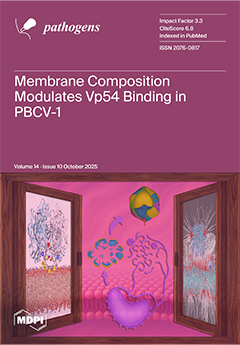Campylobacter hepaticus is the etiological agent of Spotty Liver Disease (SLD), a newly emerging bacterial disease of laying hens resulting in significant mortality and production losses primarily in free-range systems. Although its economic impact continues to grow, the molecular basis of
C. hepaticus pathogenesis remains poorly understood. In this study, we conducted transcriptomic profiling of
C. hepaticus in three host-relevant conditions, exposure to chicken bile, infection of a chicken liver hepatocellular carcinoma (LMH) cell line, and isolation from liver lesions of naturally infected chickens. Through RNA-seq analysis, we found unique gene expression signatures in each environment. In the bile,
C. hepaticus exhibited differential expression of 412 genes, with upregulation of genes related to motility, cell envelope remodeling, glycosylation, nitrate respiration, and multidrug efflux systems, indicating a stress-adaptive, metabolically active lifestyle. In LMH, on the other hand, 125 genes were differentially expressed, primarily reflecting downregulation of motility, oxidative stress response, chaperones, and core metabolic processes, suggesting that these cells adopt a less active, intracellular dormant lifestyle. Transcriptomic analysis of
C. hepaticus isolated from the liver identified 26 differentially expressed genes, featuring selective upregulation of genes associated with nitrate respiration, sulfur metabolism, and pyridoxal 5’ phosphate homeostasis, alongside downregulation of the major outer membrane porin (
momp), stress response chaperones (
dnaK,
groL), and genes involved in oxidative stress defense and energy production. Furthermore, the immune evasion-related gene
cmeA and a glycosyltransferase gene were found to be highly upregulated. This study presents the first in-depth transcriptomic exploration of
C. hepaticus in multiple host relevant niches. Our findings reveal niche-specific gene expression profiles and highlight metabolic and structural adaptations that enable
C. hepaticus to survive during bile exposure, persist within host cells, and contribute to liver pathology. These insights provide a basis for identifying novel virulence determinants and may inform the development of targeted interventions, including vaccines or antimicrobial therapy, to control SLD in commercial poultry operations.
Full article






